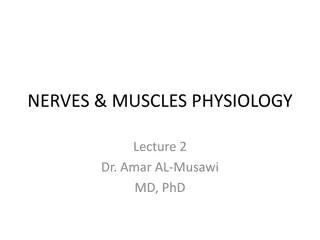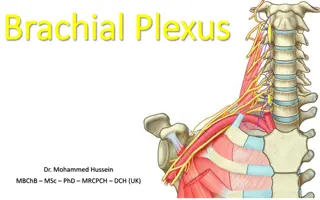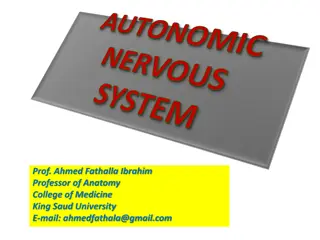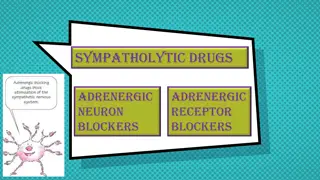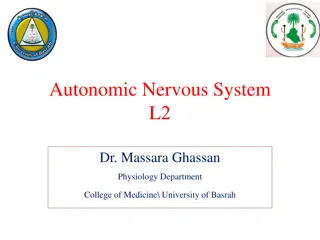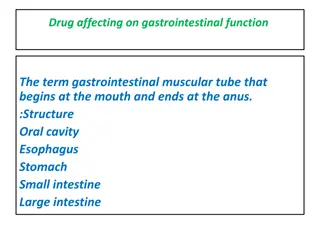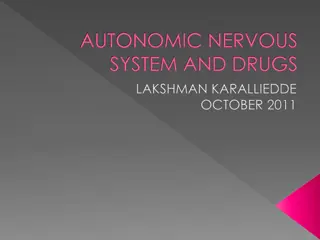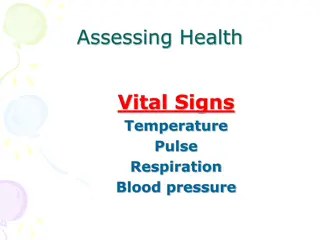Understanding Adrenergic Agents in Pharmaceutical Chemistry
Adrenergic agents play a crucial role in pharmacology by influencing the sympathetic nervous system through adrenergic receptors. These agents, such as sympathomimetics and sympatholytics, impact essential functions like cardiac activity, blood vessel dilation, and insulin release. Adrenergic neurot
0 views • 120 slides
Meet Your Immigration Attorney
Avoid becoming overwhelmed by the immigration procedure. Marcellepoirier.com offers skilled, sympathetic immigration lawyer services to assist you in navigating the intricacies of the system.\n\n\/\/marcellepoirier.com\/
3 views • 1 slides
Understanding Nerves and Muscles Physiology: Lecture Insights by Dr. Amar AL-Musawi MD, PhD
Delve into the intricacies of cardiac action potential, mechanism of action potential propagation, rhythmicity in excitable tissues, and the crucial concept of refractory period. Explore how voltage-gated channels influence the duration of action potential and learn about the spontaneous generation
0 views • 12 slides
Understanding the Cervical Part of Sympathetic Trunks
The sympathetic trunks play a crucial role in the human body, with the cervical part located in front of the transverse processes of cervical vertebrae and the neck of the 1st rib. This part presents three ganglia - superior, middle, and inferior. Sometimes, the inferior cervical and first thoracic
0 views • 25 slides
Understanding the Brachial Plexus Anatomy and Function
The brachial plexus is a crucial network of nerves in the upper limb, formed by nerve fibers originating from C5 to T1 spinal levels. It plays a significant role in innervating the upper extremity muscles and providing sensory feedback. The plexus is categorized into roots, trunks, divisions, cords,
0 views • 55 slides
Anatomy of the Prevertebral Region in the Neck
The prevertebral region in the neck extends from the 1st cervical vertebra to the upper two thoracic vertebrae. It includes structures like prevertebral and paravertebral muscles, cervical plexus, sympathetic chains, and large vessels. The prevertebral muscles, including rectus capitis anterior and
0 views • 15 slides
Understanding Cutaneous Circulation and Blood Supply in Different Body Regions
Cutaneous circulation plays a vital role in supplying blood to the skin, with variations in apical and non-apical regions of the body. The blood flow is regulated by neural, thermal, and metabolic factors, and controlled by sympathetic fibers. Sympathetic vasoconstriction and vasodilation affect the
0 views • 19 slides
Understanding Adrenergic Transmission and Catecholamine Synthesis
Adrenergic transmission involves the release of neurotransmitters such as norepinephrine, dopamine, and epinephrine at synapses or neuroeffector junctions. These neurotransmitters, known as catecholamines, play crucial roles in transmitting impulses in the sympathetic nervous system and central nerv
0 views • 14 slides
Analyzing Description of Magwitch in "Great Expectations
In "Great Expectations" by Charles Dickens, the writer uses descriptive language to introduce Magwitch, an escaped convict, as a fearful yet pitiful figure through detailed noun phrases. This analysis explores the mixed emotions evoked by Magwitch's portrayal, inviting readers to consider whether to
0 views • 7 slides
Sonnet to the Moon by Sir Philip Sidney: A Poetic Ode to Unrequited Love
Born in 1554, Sir Philip Sidney was an Elizabethan courtier, poet, and scholar. "Sonnet to the Moon" from his work "Astrophel and Stella" explores unrequited love through an address to the moon as a sympathetic observer. The poem reflects on the nature of love, beauty, and virtue. With eloquent imag
0 views • 9 slides
Medication-assisted Treatment Columbus | Suboxonecolumbus.net
Suboxonecolumbus.net offers medication-assisted treatment in Columbus that can help you find healing and hope. Our sympathetic staff is available to assist you on your road to recovery.
4 views • 1 slides
Understanding the Autonomic Nervous System in Anatomy Lecture
In this anatomy lecture by Prof. Ahmed Fathalla Ibrahim from King Saud University, students will learn about the autonomic nervous system. The objectives include defining the system, describing its structure, and tracing neurons in both sympathetic and parasympathetic systems. The lecture also cover
1 views • 17 slides
Understanding Respiratory System Pharmacology and Cough Physiology
The regulation of respiration involves sensory and efferent pathways, with afferent pathways comprising stretch receptors, C-fibres, and irritant receptors, while efferent pathways include parasympathetic and sympathetic nerves. Cough physiology is a protective reflex initiated by various stimuli to
2 views • 43 slides
How to Pick the Best Material for Your Swimwear
Explore our swimwear Gold Coast Australia collection, designed for active, style-conscious beachgoers. Featuring high-performance board shorts and sleek swim trunks, each piece combines comfort, durability, and standout design. Shop Now at : \/\/bist
0 views • 2 slides
Understanding Adrenergic Neuron Blockers: Mechanisms and Pharmacological Effects
Explore the mechanisms of action of adrenergic neuron blockers and classify adrenergic receptor blockers into selective and non-selective categories. Delve into the pharmacokinetic aspects and pharmacodynamic effects of these blockers, such as false transmitter formation, store depletion, release in
0 views • 29 slides
Ohio Suboxone Doctors | Suboxonecolumbus.net
Visit SuboxoneColumbus.net to find skilled and sympathetic Ohio Suboxone physicians. Get the help and therapy you require to kick your addiction.
4 views • 1 slides
Caring Tips for Mens Swimwear
Discover the coastal way of life with our selection of men's swimwear Sydney. Each item, which includes high-quality board shorts and swim trunks, blends fashion with utility for well-known beaches like Bondi and Manly. Whether you're swimming, surfi
0 views • 5 slides
Understanding the Formation and Structure of Brachial Plexus
Learn about the formation, divisions, trunks, cords, and branches of the brachial plexus in this detailed lecture with clear objectives and diagrams, guiding students to describe and list the main components of the brachial and lumbosacral plexuses. Discover the stages of the plexus, from roots to b
0 views • 27 slides
Overview of the Nervous System Components and Functions
The nervous system is comprised of the central nervous system (CNS) and the peripheral nervous system (PNS). The CNS acts as the command center, interpreting sensory information and coordinating responses. The PNS conveys information to and from the CNS through somatic and visceral sensory neurons,
0 views • 48 slides
Analyzing Characters through AECR Method in Literature Studies
The lesson involves analyzing characters through dialogue and incidents, supported by evidence and commentary using the AECR method. Students discuss vocabulary, choose impactful words, and present arguments such as whether Mary Maloney in "Lamb to the Slaughter" is sympathetic. The Assertion, Evide
0 views • 13 slides
Understanding the Autonomic Nervous System Functions and Effects
Explore the functions of the sympathetic and parasympathetic nervous systems, the distinct effects they have on various organs, and the differences between anabolic and catabolic responses. Learn about the specific organs supplied by each division and how their activation impacts bodily functions. G
0 views • 25 slides
Therapeutic Strategies in Heart Failure Management
Heart failure is a serious condition characterized by inadequate cardiac output. Compensatory responses include sympathetic nervous system activation, renin-angiotensin-aldosterone system stimulation, and natriuretic peptide release. Pharmacologic therapies target salt and water retention, afterload
0 views • 25 slides
Understanding Gastrointestinal Function and Its Regulation by Drugs
The gastrointestinal tract, a muscular tube from the mouth to the anus, is influenced by drugs affecting its function. Structures vary in different animals, with control by the autonomic nervous system branches. Parasympathetic stimulation increases motility, while sympathetic stimulation decreases
0 views • 36 slides
Understanding Student Engagement with Augmented Reality Sandbox
Engagement in learning is crucial for student progress, with a focus on how individuals participate in purposeful educational activities. This study explores the use of skin biosensors to measure sympathetic activation as a proxy for engagement in students while using an augmented reality sandbox. T
0 views • 24 slides
Unusual Images Collection - Hollow Tree Trunks, Patient Scenes, Slim Fashion & Rare Finds
Explore a unique assortment of images showcasing hollow tree trunks, patient moments, slim fashion, and rare discoveries. From eerie tree trunks to intriguing fashion trends, these images offer a glimpse into diverse scenes worth discovering.
0 views • 11 slides
Managing Chronic Pain in Schools and Colleges: Insights from Dr. Konrad Jacobs
Explore the challenges of managing pain, fatigue, and physical symptoms without clear pathology in educational settings. Learn about acute versus chronic pain, the purpose of pain, effects of the sympathetic nervous system, and the role of expectations in pain experiences.
0 views • 39 slides
Evolution of Drug Depictions in Cinema
Explore the portrayal of drug use and addiction in films throughout history, from sensationalized and sympathetic depictions to censorship issues under the Motion Picture Production Code. Discover how cultural attitudes towards drug use have changed over time and how filmmakers have navigated these
0 views • 6 slides
Understanding Verbal and Non-Verbal Communication
Verbal communication involves both speaking and listening, with listening being equally essential. It can be classified into sympathetic and empathetic listening, each serving different purposes in understanding others' feelings. Sympathetic listening involves sharing emotions, while empathetic list
0 views • 52 slides
Understanding Stress Response and its Impact on the Body
Stressful situations trigger a cascade of physiological changes known as the "fight-or-flight" response. The body's hormonal and physiological reactions help in coping with threats, but overreactions to non-life-threatening stressors can occur. The brain's command center, the hypothalamus, communica
0 views • 10 slides
Understanding the Autonomic Nervous System and Its Functions
The autonomic nervous system (ANS) plays a crucial role in regulating internal processes such as blood pressure, heart rate, digestion, and metabolism. Comprising the sympathetic and parasympathetic divisions, it ensures the body responds appropriately to different situations. Dysfunctions can lead
0 views • 60 slides
Understanding Body Temperature Regulation and Factors Affecting It
Body temperature regulation is a complex process involving the balance of heat production and loss. Factors like age, hormones, stress, and environmental changes can influence body temperature. Heat production is affected by factors such as basal metabolic rate, muscle activity, fever, and sympathet
0 views • 24 slides
Adolescent Psychiatry Adapsychiatry.com
At Adapsychiatry.com, you will get adolescent psychiatry services that are both professional and sympathetic. Encouraging the growth of young brains is our team's top priority.\n\n\/\/ \/
6 views • 1 slides
Ethical Dilemmas in Animal Rights Discussion
Engage in a thought-provoking class discussion led by Great Blue Heron on ethical dilemmas in animal rights, exploring themes like speciesism, tolerance, and the use of sympathetic imagination. Delve into common stories, differing views on vivisection, and the need for greater understanding between
0 views • 7 slides


